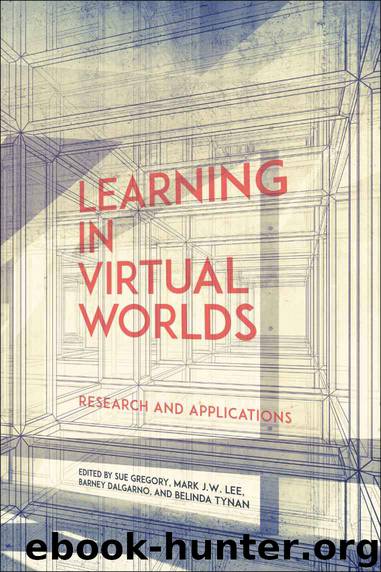Learning in Virtual Worlds by Learning in Virtual Worlds; Research & Applications

Author:Learning in Virtual Worlds; Research & Applications
Language: eng
Format: epub
Publisher: Athabasca University Press
Published: 2016-03-31T16:00:00+00:00
PART TWO
ADVANCED TECHNOLOGY
7 CONVERSATIONAL AGENTS IN SECOND LIFE
Freudbot
Bob Heller, Mike Procter, and Corbin Rose
Conversational agents (CAs), also known as chatbots, are computer programs that are designed to chat with users using the rules of conversation and turn-taking (see http://www.chatbots.org for examples). As noted by Kerly, Ellis, and Bull (2009), the use of CAs in education is growing significantly as conversational technologies mature, and can be seen in a wide variety of educational applications including tutoring, question-answering, second language learning, learning companions, and reflective dialogues. Although evidence for their value may be equivocal (see Clark & Choi, 2005; Dehn & van Mulken, 2000; Gulz, 2004; Gulz & Haake, 2006 for reviews of animated pedagogical agents, a closely related technology) the rationale for their use is sound. Conversational agents provide an engaging and intuitive interface to a body of knowledge that can be accessed in a personalized and adaptable format (Cassell, Sullivan, Prevost, & Churchill, 2000).
In our studies with conversational agents, we investigated a historical figure application on the assumption that distance education students would be highly motivated to chat with famous historical theorists in psychology. Subsequent research supported this assumption, as historical figures were rated as one of the best applications of conversational agents (Heller, Procter, Mah, Jewell, & Cheung, 2005) and other authors have suggested historical figures as a fertile application space for conversational agents and animated pedagogical agents (Payr, 2003; Veletsianos & Miller, 2008).
Our first historical agent was Freudbot (Heller et al., 2005), which was patterned after Sigmund Freud and created using Artificial Intelligence Markup Language (AIML), an XML-based programming language developed by Richard Wallace (see http://www.alicebot.org), one of the most widely used programming platforms for chatbot development, as reflected in the website Pandorabots (http://www.pandorabots.com), a hosting service for AIML-based chatbots, with over 1.3 billion responses served. Typically, users converse with AIML chatbots by typing their comment or question in a text window—the agent responds immediately after the user submits his or her input. At its core, AIML is a pattern-matching program and thus is similar to Eliza, the grandmother of all chatbots (Weizebaum, 1966). However, unlike Eliza, AIML enables a recursion property that reduces user input into different symbolic categories, thus enabling a chatbot response appropriate to the conversational context.
Freudbot’s “knowledge” is stored in the form of first-person narratives. The narratives are presented in chunks as long as the user types appropriate conversational prompts to advance the story either explicitly (“Tell me more”) or implicitly (“That’s interesting”). In some cases, Freudbot can answer questions that are anticipated from the narrative output. The importance of narratives as a vehicle for knowledge transmission has been recognized in intelligent tutoring systems (McQuiggan, Robinson, & Lester, 2010) and is well suited as a medium for CAs as historical figures. In total, Freudbot possessed close to 90 stories related to his theories and biography. In cases where the user input was not “recognized,” Freudbot would default to a conversationally appropriate request in order to “direct” the user to a relevant conversational narrative.
Heller et al.
Download
This site does not store any files on its server. We only index and link to content provided by other sites. Please contact the content providers to delete copyright contents if any and email us, we'll remove relevant links or contents immediately.
| Administration | Assessment |
| Educational Psychology | Experimental Methods |
| History | Language Experience Approach |
| Philosophy & Social Aspects | Reform & Policy |
| Research |
The Art of Coaching Workbook by Elena Aguilar(50038)
Trainspotting by Irvine Welsh(20940)
Twilight of the Idols With the Antichrist and Ecce Homo by Friedrich Nietzsche(18266)
Fangirl by Rainbow Rowell(8754)
Periodization Training for Sports by Tudor Bompa(7888)
Change Your Questions, Change Your Life by Marilee Adams(7319)
This Is How You Lose Her by Junot Diaz(6401)
Asking the Right Questions: A Guide to Critical Thinking by M. Neil Browne & Stuart M. Keeley(5319)
Grit by Angela Duckworth(5262)
Red Sparrow by Jason Matthews(5165)
Paper Towns by Green John(4752)
Room 212 by Kate Stewart(4703)
Ken Follett - World without end by Ken Follett(4410)
The Sports Rules Book by Human Kinetics(4042)
Housekeeping by Marilynne Robinson(4016)
Double Down (Diary of a Wimpy Kid Book 11) by Jeff Kinney(3873)
Papillon (English) by Henri Charrière(3870)
The Motorcycle Diaries by Ernesto Che Guevara(3754)
Exercise Technique Manual for Resistance Training by National Strength & Conditioning Association(3754)
